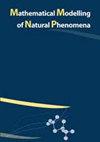3 × 3广义Chaplygin气体方程解的消失压力极限中的浓度和空化
IF 2.6
4区 数学
Q2 MATHEMATICAL & COMPUTATIONAL BIOLOGY
引用次数: 0
摘要
通过研究小参数广义Chaplygin气体(GCG) 3×3等熵可压缩欧拉方程解的消失压力极限,识别和分析了浓度和空化现象。严格证明了GCG方程的任何包含两个激波和可能的一个接触不连续的Riemann解在参数减小到某一临界值时收敛于同一系统的delta激波解。当参数趋近于零即压力消失时,极限解仅为无压气体动力学(PGD)模型的δ激波解,两激波之间的中间密度趋于加权δ量,形成δ激波;任何包含两个稀疏波和可能的一个接触不连续的黎曼解都趋向于PGD模型的两个接触不连续解,两者之间的非真空中间态趋向于真空态。最后,给出了一些数值结果,展示了随着压力的降低,浓度和空化的过程。本文章由计算机程序翻译,如有差异,请以英文原文为准。
Concentration and cavitation in the vanishing pressure limit of solutions to a 3 × 3 generalized Chaplygin gas equations
The phenomena of concentration and cavitation are identified and analyzed by studying the vanishing pressure limit of solutions to the 3×3 isentropic compressible Euler equations for generalized Chaplygin gas (GCG) with a small parameter. It is rigorously proved that, any Riemann solution containing two shocks and possibly one-contact-discontinuity of the GCG equations converges to a delta-shock solution of the same system as the parameter decreases to a certain critical value. Moreover, as the parameter goes to zero, that is, the pressure vanishes, the limiting solution is just the delta-shock solution of the pressureless gas dynamics (PGD) model, and the intermediate density between the two shocks tends to a weighted δ -measure that forms the delta shock wave; any Riemann solution containing two rarefaction waves and possibly one contact-discontinuity tends to a two-contact-discontinuity solution of the PGD model, and the nonvacuum intermediate state in between tends to a vacuum state. Finally, some numerical results are presented to exhibit the processes of concentration and cavitation as the pressure decreases.
求助全文
通过发布文献求助,成功后即可免费获取论文全文。
去求助
来源期刊

Mathematical Modelling of Natural Phenomena
MATHEMATICAL & COMPUTATIONAL BIOLOGY-MATHEMATICS, INTERDISCIPLINARY APPLICATIONS
CiteScore
5.20
自引率
0.00%
发文量
46
审稿时长
6-12 weeks
期刊介绍:
The Mathematical Modelling of Natural Phenomena (MMNP) is an international research journal, which publishes top-level original and review papers, short communications and proceedings on mathematical modelling in biology, medicine, chemistry, physics, and other areas. The scope of the journal is devoted to mathematical modelling with sufficiently advanced model, and the works studying mainly the existence and stability of stationary points of ODE systems are not considered. The scope of the journal also includes applied mathematics and mathematical analysis in the context of its applications to the real world problems. The journal is essentially functioning on the basis of topical issues representing active areas of research. Each topical issue has its own editorial board. The authors are invited to submit papers to the announced issues or to suggest new issues.
Journal publishes research articles and reviews within the whole field of mathematical modelling, and it will continue to provide information on the latest trends and developments in this ever-expanding subject.
 求助内容:
求助内容: 应助结果提醒方式:
应助结果提醒方式:


